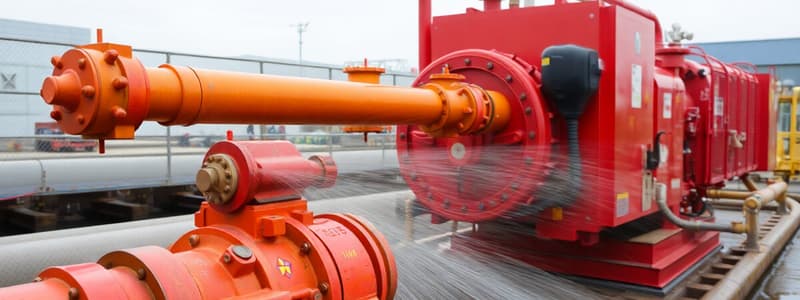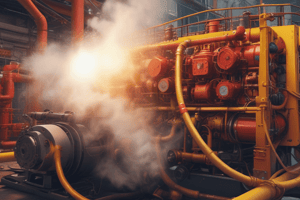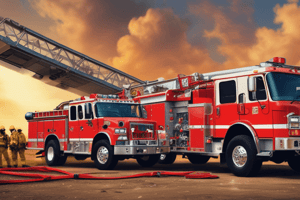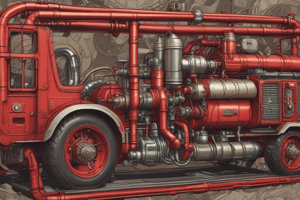Podcast
Questions and Answers
What is the primary emphasis of the provided manual regarding hydraulics?
What is the primary emphasis of the provided manual regarding hydraulics?
- Detailed mathematical derivations of hydraulic formulas.
- Comprehensive analysis of various liquids and their specific behaviors under pressure.
- Practical application of hydraulic principles in firefighting operations, particularly concerning water and pressure in hose lines. (correct)
- Historical overview of hydraulic principles and their evolution.
Why is understanding basic hydraulic theories and principles crucial for producing effective fire streams?
Why is understanding basic hydraulic theories and principles crucial for producing effective fire streams?
- It ensures that the water used is free of contaminants.
- It allows firefighters to quickly estimate the distance to the fire.
- It enables pump operators to effectively manage nozzle pressure, GPM flow, friction loss, and elevation changes to establish and maintain effective fire streams. (correct)
- It helps in selecting the correct type of fire extinguisher for different types of fires.
Why should firefighters and pump operators perform complex mathematical problem-solving related to hydraulics during training rather than at the scene of a fire?
Why should firefighters and pump operators perform complex mathematical problem-solving related to hydraulics during training rather than at the scene of a fire?
- To ensure the fire scene remains quiet and orderly.
- To avoid using calculators in a potentially hazardous environment.
- To enable quicker and more efficient decision-making under pressure, as well as to allow pump operators to perform 'street math' effectively. (correct)
- To conserve resources by minimizing water usage during firefighting operations.
What critical awareness should firefighters at the end of a hose line possess, gained through training and experience?
What critical awareness should firefighters at the end of a hose line possess, gained through training and experience?
What does being 'over-pressurized' typically indicate in the context of a fire hose line?
What does being 'over-pressurized' typically indicate in the context of a fire hose line?
What is the significance of understanding the weight of water in firefighting operations?
What is the significance of understanding the weight of water in firefighting operations?
How does the weight of water relate to its volume?
How does the weight of water relate to its volume?
According to the information provided, what is the approximate weight of a 50-foot section of 1 3/4" (1.88") Firequip Combat Master Flow hose when fully charged with water?
According to the information provided, what is the approximate weight of a 50-foot section of 1 3/4" (1.88") Firequip Combat Master Flow hose when fully charged with water?
What is the approximate static amount of water (in gallons) contained in a 200' charged 1 3/4" hose line prior to water flowing?
What is the approximate static amount of water (in gallons) contained in a 200' charged 1 3/4" hose line prior to water flowing?
Approximately how much does a 50' section of 2 1/2" Firequip Municipal Fire Hose, DJ 800, Nylon-Rubber-Lined, 2 ½” NST couplings weigh when fully charged with water?
Approximately how much does a 50' section of 2 1/2" Firequip Municipal Fire Hose, DJ 800, Nylon-Rubber-Lined, 2 ½” NST couplings weigh when fully charged with water?
Why should drivers, officers, and nozzle firefighters be attentive when fire attack includes long stretches of 3” hose to the 2nd in bag, according to the scenario provided?
Why should drivers, officers, and nozzle firefighters be attentive when fire attack includes long stretches of 3” hose to the 2nd in bag, according to the scenario provided?
How does the manual define static pressure in the context of hydraulics?
How does the manual define static pressure in the context of hydraulics?
How does the manual define residual pressure in the context of hydraulics?
How does the manual define residual pressure in the context of hydraulics?
Why is it beneficial for firefighters to think of water application in terms of 'gallons per second' (GPS) rather than 'gallons per minute' (GPM)?
Why is it beneficial for firefighters to think of water application in terms of 'gallons per second' (GPS) rather than 'gallons per minute' (GPM)?
According to the manual, what is the MOST precise way to determine friction loss?
According to the manual, what is the MOST precise way to determine friction loss?
What is the consequence of applying general 'rules-of-thumb' regarding friction loss, potentially leading to excessively high pump discharge pressures (PDP)?
What is the consequence of applying general 'rules-of-thumb' regarding friction loss, potentially leading to excessively high pump discharge pressures (PDP)?
According to internal PFD testing, what is the friction loss per 50' of 1 ¾” (1.88”) hose line @ 185 GPMs?
According to internal PFD testing, what is the friction loss per 50' of 1 ¾” (1.88”) hose line @ 185 GPMs?
Why does the manual advocate for dismissing the use of coefficients when determining friction loss (FL) in fire hoses?
Why does the manual advocate for dismissing the use of coefficients when determining friction loss (FL) in fire hoses?
According to the manual, where should discharge pressure be measured to accurately determine friction loss (FL) in the hose line?
According to the manual, where should discharge pressure be measured to accurately determine friction loss (FL) in the hose line?
What is the primary utility of in-line gauges in the context of smooth bore nozzles, and what alternative tool is considered more accurate?
What is the primary utility of in-line gauges in the context of smooth bore nozzles, and what alternative tool is considered more accurate?
According to the information provided, what is the basis for Nozzle Reaction?
According to the information provided, what is the basis for Nozzle Reaction?
What is the importance of matching the target flow to the BTUs being produced by a fire?
What is the importance of matching the target flow to the BTUs being produced by a fire?
What factor MOST influences the style and techniques that firefighters employ to manage nozzle reaction?
What factor MOST influences the style and techniques that firefighters employ to manage nozzle reaction?
According to the manual, what is 'Target Flow'?
According to the manual, what is 'Target Flow'?
According to the information provided, what is the formula for 'Nozzle Reaction'?
According to the information provided, what is the formula for 'Nozzle Reaction'?
What is the term used for the net or end result of hose calculations, representing the amount of pressure provided by the pump to achieve the target flow?
What is the term used for the net or end result of hose calculations, representing the amount of pressure provided by the pump to achieve the target flow?
When determining pump pressure, what elevation consideration should be made?
When determining pump pressure, what elevation consideration should be made?
When determining pump pressure, what consideration should be made for any appliances flowing greater than 350 GPM?
When determining pump pressure, what consideration should be made for any appliances flowing greater than 350 GPM?
When determining pump pressure, what consideration should be made if there is a standpipe, snorkel, tower ladder, ladder pipe, or large manifold involved?
When determining pump pressure, what consideration should be made if there is a standpipe, snorkel, tower ladder, ladder pipe, or large manifold involved?
Why is it important for a DPOP to have information about Target Flow, GPM, Friction Loss, and Nozzle Pressure prior to arriving on the scene?
Why is it important for a DPOP to have information about Target Flow, GPM, Friction Loss, and Nozzle Pressure prior to arriving on the scene?
What is the potential downside of choosing a higher target flow with a 1 3/4" hose line compared to using a 2 1/2" hose line?
What is the potential downside of choosing a higher target flow with a 1 3/4" hose line compared to using a 2 1/2" hose line?
According to the manual, what is the formula for pump discharge pressure (PDP)?
According to the manual, what is the formula for pump discharge pressure (PDP)?
In the PDP formula, what does the variable 'AL' represent?
In the PDP formula, what does the variable 'AL' represent?
According to provided table, what is the approximate nozzle reaction of a hand-held smooth bore tip flowing at 265 gallons per minute?
According to provided table, what is the approximate nozzle reaction of a hand-held smooth bore tip flowing at 265 gallons per minute?
What is the MOST critical aspect of hydraulics for firefighters to understand in order to ensure operational effectiveness and safety?
What is the MOST critical aspect of hydraulics for firefighters to understand in order to ensure operational effectiveness and safety?
Considering the information provided, which of the following scenarios would MOST necessitate the use of a 2 ½" hose line over a 1 ¾" hose line?
Considering the information provided, which of the following scenarios would MOST necessitate the use of a 2 ½" hose line over a 1 ¾" hose line?
Why does the manual advocate that pump operators should be proficient in performing 'street math' at an emergency?
Why does the manual advocate that pump operators should be proficient in performing 'street math' at an emergency?
What is the MOST significant reason for firefighters to understand the relationship between the weight and volume of water?
What is the MOST significant reason for firefighters to understand the relationship between the weight and volume of water?
According to the manual, what is the direct consequence of a lack of familiarity with nozzle type, target flow, and needed nozzle pressure for firefighters, especially driver operators?
According to the manual, what is the direct consequence of a lack of familiarity with nozzle type, target flow, and needed nozzle pressure for firefighters, especially driver operators?
How does the manual suggest firefighters can more accurately determine friction loss (FL) in a hose line, moving away from traditional methods?
How does the manual suggest firefighters can more accurately determine friction loss (FL) in a hose line, moving away from traditional methods?
What is the MOST critical reason for a Driver/Pump Operator (DPOP) to have comprehensive knowledge of Target Flow, GPM, Friction Loss, and Nozzle Pressure before arriving at the scene of a fire?
What is the MOST critical reason for a Driver/Pump Operator (DPOP) to have comprehensive knowledge of Target Flow, GPM, Friction Loss, and Nozzle Pressure before arriving at the scene of a fire?
Flashcards
What is Hydraulics?
What is Hydraulics?
The physical science of the properties of liquids at rest or in motion.
Why study hydraulics?
Why study hydraulics?
Understanding hydraulic theories and principles is needed to create effective fire streams.
What factors influence effective fire streams?
What factors influence effective fire streams?
Nozzle Pressure, GPM flow, friction loss, appliance friction loss, and elevation changes.
What are the dangers of over/under-pressurized lines?
What are the dangers of over/under-pressurized lines?
Signup and view all the flashcards
Why is water the primary suppression agent?
Why is water the primary suppression agent?
Signup and view all the flashcards
Which physical property of water is most important?
Which physical property of water is most important?
Signup and view all the flashcards
How are weight and volume related?
How are weight and volume related?
Signup and view all the flashcards
What is Static Pressure?
What is Static Pressure?
Signup and view all the flashcards
What is Residual Pressure?
What is Residual Pressure?
Signup and view all the flashcards
What is Gallons Per Minute (GPM)?
What is Gallons Per Minute (GPM)?
Signup and view all the flashcards
What is Friction Loss (FL)?
What is Friction Loss (FL)?
Signup and view all the flashcards
How does raising PDP affect nozzle pressure?
How does raising PDP affect nozzle pressure?
Signup and view all the flashcards
More water = more what?
More water = more what?
Signup and view all the flashcards
What factors influence friction loss?
What factors influence friction loss?
Signup and view all the flashcards
Best way to determine friction loss?
Best way to determine friction loss?
Signup and view all the flashcards
What is Nozzle Reaction based on?
What is Nozzle Reaction based on?
Signup and view all the flashcards
What dictates nozzle reaction?
What dictates nozzle reaction?
Signup and view all the flashcards
What is nozzle reaction essentially?
What is nozzle reaction essentially?
Signup and view all the flashcards
What is the Target Flow?
What is the Target Flow?
Signup and view all the flashcards
What factors determine Pump Discharge Pressure (PDP)?
What factors determine Pump Discharge Pressure (PDP)?
Signup and view all the flashcards
Study Notes
Basic Firefighting Hydraulics
- This manual provides general information about basic firefighting hydraulics.
- Each member must exercise appropriate control as dictated by rank for implementation.
- Hydraulics is the physical science of liquid properties at rest or in motion.
- A thorough understanding of basic hydraulic principles and water application is the foundation for efficient water supply and pumping operations.
- To create effective fire streams, pump operators need to know nozzle pressure, GPM flow, friction loss in the fire hose, friction loss in appliances, and pressure loss or gain from elevation changes.
- Pump operators should be able to perform "street math" at an emergency.
- Firefighters need to be aware of problems with the line (over/under-pressurized, burst length) through training.
- Over-pressurized lines lead to increased nozzle reaction, fatigue, increased air consumption, and reduced application rate by shutting down the line.
- Under-pressurized lines mean inadequate GPM, slower water velocity, and kink issues.
- Both scenarios with unsafe conditions for interior crews and confusion on the radio.
- Firefighters and drivers need to be familiar with nozzle type, target flow, and nozzle pressure.
Water Usage
- Water is the primary fire suppression agent because it is cheap, available, and supremely effective.
- A properly pressurized hose line with adequate GPM is the most useful tool.
- Weight is the physical property of water most important to firefighters.
- Incident commanders should be aware of the added weight of high-volume water application in defensive operations.
- Officers need to be aware of the weight of water when choosing attack lines.
- Water weight is directly proportional to the volume.
Volume Measurements
- 1 ¾” (1.88”) Firequip Combat Master Flow:
- 19 lbs dry/uncharged per 50'
- 7.21 gallons per 50'
- 60.17 lbs water weight per 50'
- ~80 lbs per 50' fully charged
- 28.84 gallons static in a 200' charged 1 ¾” hose line
- 2 ½” Firequip Municipal Fire Hose, DJ 800, Nylon-Rubber-Lined, 2 ½” NST couplings:
- 26 lbs dry/uncharged per 50'
- 12.75 gallons per 50'
- 106.4 lbs water weight per 50'
- 132.4 lbs fully charged
- 51 gallons static in a 200' charged 2 ½” hose line
- 3” Firequip Hydro Flow Small Diameter (SDH) Supply Line, 2 ½” NST couplings:
- 33 lbs dry/uncharged per 50'
- 18.36 gallons per 50'
- 153.21 lbs water weight per 50'
- 186.21 lbs fully charged
- Using 4 lengths of 3” to a gated wye (73.44 gallons) with 3 lengths of 1 ¾” (21.63 gallons) hose line will take 95.07 gallons of water to fill the supply and attack line.
- 5” LDH:
- 105 lbs dry/uncharged per 100'
- 102 gallons per 100'
- 851 lbs water weight
- 955 lbs charged
Hydraulics Terms
- Static Pressure: Pressure in a system or hose line with no water flowing.
- Residual Pressure: Amount of pressure left in the system while water is flowing.
- Gallons per Minute (GPM): Measures volume of flow from a hose line or pump.
- Gallons per Second (GPS): Measures water application in seconds, useful for visualizing impact of small amounts of water.
- Friction Loss (FL): The energy lost by water as it travels through a hose, measured by the difference between pump pressure and nozzle pressure via reading from discharge outlet to nozzle.
- With increased pump discharge pressure, the nozzle pressure increase is not equal to the engine pressure rise.
- More friction loss with more water being moved through the same size hose line.
- Less friction loss occurs with less water being moved through the same size hose line.
- Friction loss characteristics have changed with evolving hose technology.
- Overly conservative friction loss characteristics can lead to excessively high PDP, while optimistic estimations can inhibit efficiency.
- Internal PFD testing indicates Friction Loss per 50' of 1 ¾” (1.88”) hose line at 185 GPMs is 17 PSI.
Friction Loss Information
- Exact allowances cannot be made for friction loss due to variations in condition, design, manufacture, and age of fire hose, along with attached appliances.
- Determine FL by dismissing coefficients and following a precise process: removing internal Friction Loss from calculations for the hose line.
- Measure discharge pressure from the actual discharge, not just PDP, to determine FL in the hose line, it is impacted by plumbing and age of apparatus.
- To measure friction loss, place the 2 ½” in-line gauge from the high-rise kit on the discharge and the 1 ½” in-line gauge behind the nozzle and find the difference.
- In-line gauges help determine NP for smooth bore nozzles, pitot gauges are more accurate.
Nozzle
- Pitot gauges cannot be used on fog nozzles due to the broken stream, but in-line gauges can be used on smooth bore in the absence of pitot gauges.
- Pitot gauges are more accurate, regardless.
- Nozzle Reaction is based on Newton’s first law of motion: equal and opposite reaction based on water volume and pressure.
- Nozzle reaction is the backpressure that is being created in the last 3’ of line before the nozzle.
- 1 firefighter can effectively handle 60 lbs of reaction force
- 2 firefighters can effectively handle 75 lbs of reaction force
- 3 firefighters needed to handle 95 lbs of reaction force
- Techniques, body mechanics, time on the job, and fitness can combat nozzle reaction.
- Target flow should match BTUs being produced, not fatigue the nozzle firefighter, and not create a kinked hose line or excessive whipping.
- Nozzle reaction management depends on staffing and nozzle type.
Target Flow and Pressure
- Target Flow is the GPM amount that a DPOP aims to achieve through proper Pump Discharge Pressure.
- PDP, also known as engine pressure, is the net result of hose calculations.
- PDP is calculated by adding Nozzle Pressure, Friction Loss, Appliance loss, and Elevation pressure.
Calculating Pump Pressure
- Determining Pump Pressure:
- Desired nozzle pressure?
- Target flow (GPM)?
- Hose line diameter being deployed?
- Friction loss per 50' length of the hose?
- Elevation to consider (+5 PSI per floor)?
- Appliances flowing greater than 350 GPM (+5 PSI)?
- Standpipe, snorkel, tower ladder, ladder pipe or large manifold involved (+25 PSI)?
Fireground Tactics
- Target Flow, GPM, Friction Loss, and Nozzle Pressure are information a DPOP should have before arrival
- Length of the stretch and elevation will be situation specific.
- When operating with pre-connected hose lines, the information to achieve proper PDP should be established, except for elevation.
- Companies can have different target flows based on conditions
- Heavy fire in a tire shop = higher target flow based on fire load (230 GPM @ 100lbs NP)
- A 2 ½” hose line is always an option for occupancies and fire loads that demand higher GPMs to overcome the BTUs being produced.
- PDP has to be increased with a 1 ¾” hose line to overcome the increased FL created by the higher amount of GPMs being flowed.
- With higher flows through 1 ¾” lines, there is a ceiling far below the max capacity of a 2 ½” hose line.
- 2 ½” traditionally flows 265 GPM with 50lbs NP if operating with a 1 1/8” tip
- Aim a higher flow of 325 GPM with 50lbs NP and a 1 ¼” tip.
- Choosing the higher flow is viable, it places a larger divide between the max capacity of the 1 ¾” and the 2 ½”, but it does have a much higher nozzle reaction.
Equations
- Pump Discharge Pressure (PDP) = Nozzle Pressure + Friction Loss in the hose + Friction loss in Appliances + Pressure due to Elevation Changes.
- At a minimum, solve for NP + FL to determine the correct Pump Discharge Pressure.
- NP should be the first part of the formula to be solved for.
- PDP = NP + FL +AL + L +/- E
- PDP= engine pressure in pounds per square inch
- NP= nozzle pressure for the appliance used
- FL= total friction loss allowance in the hose line
- AL= friction created within an appliance other than standard nozzles or hose
- L= length
- E= elevation allowance
Tips and Pressure
- Hand held smooth bore tips:
- 7/8" = 160 Gallons Per Minute, 2.7 Gallons Per Second Rate, 60 Nozzle Reaction.
- 15/16" = 185 Gallons Per Minute, 3.1 Gallons Per Second Rate, 69 Nozzle Reaction.
- 1 1/8" = 265 Gallons Per Minute, 4.4 Gallons Per Second Rate, 99 Nozzle Reaction.
- 1 ½" = 325 Gallons Per Minute, 5.4 Gallons Per Second Rate, 123 Nozzle Reaction.
Studying That Suits You
Use AI to generate personalized quizzes and flashcards to suit your learning preferences.




